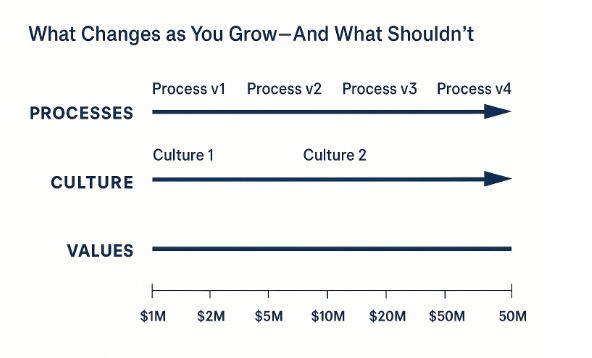By Rob Novick
Scaling a business is about more than growing revenue. It’s about building the muscles needed to help an organization grow without breaking.
For companies in the $5 to $25 million revenue range, and especially those selling services, there are many ways to manufacture growth. Healthy and sustainable growth, however, requires the right structure, the right people and the right mindset, as well as the ability to seize the opportunity when presented.
In this article, I share my thoughts on what it really takes to scale a business. My goal is to move beyond generic tips and Silicon Valley platitudes, offering real-world insights for founders and leaders facing the practical and often personal challenges of growth.
Growth Requires Letting Go
Let’s start with the hardest truth: if you want to scale, you have to stop doing everything yourself. In a service business, that means giving up billable hours, handing off client relationships, and delegating decisions. It often means making less money personally, at least for a while.
Many founders wrestle with this, and rightly so. When you’ve built a business around your own expertise, it feels counterintuitive to step back. But it’s the only way to create leverage, because scaling is contingent on your ability to enable others to do what you do well.
One example that has stuck with me came from a conversation with a leader selling his business. His secret to success? Growing by trial and error and experimentation.
This leader invested heavily in a team of young salespeople during a high-growth push, and he got results fast. He knew that an investment in a salesperson wasn’t their annual salary and bonus, because within three months he would know if he had the right resource. If he needed to, he could cut his risk and his costs at any time.
But the real key? This leader wasn’t afraid to turn over staff for non-performance. He treated hiring like a growth experiment, not a permanent commitment. That mindset: decisive, data-driven, risk-forward, and detached from ego, is what allowed him to scale.
Healthy business growth rarely happens by accident. It usually requires a decision to invest in something that seems risky, whether it’s people, technology, geography, or a new vertical. According to Salesforce’s 2024 State of Sales Report, 79% of sales leaders reported increased revenue after making strategic investments in people, enablement, or tools. The businesses that grow most rapidly aren’t simply doing more of what they’ve always done. They’re betting on something new. Those that don’t, stagnate.
Processes Will Evolve. Values Shouldn’t.
As your business grows, your processes will evolve. And they should. What worked for 10 employees won’t work for 50. Over time, your culture will shift too, especially as you bring in new leaders and teams. That’s normal.
But your values? They are the bedrock of your organization. Use them in hiring, feedback, and even in client selection. Talk about them at company meetings. Collect the stories of cultural heroes and villains and make them part of the lore of your organization.
Take the time to define your values clearly. Your values are the glue that holds your company together during the messiness of growth, and they tell people how to behave when you’re not in the room.

Seize Your Breaks. Then Leverage Them.
Every company needs a break. If you grow, you will get your stroke of fortune. Maybe it’s a marquee client. Maybe it’s a game-changing project. Maybe it’s a big-name hire.
But the mistake is treating the win like a destination instead of a launchpad.
When opportunity knocks, your job is to turn the win into a system. Serve the big client well. Use their name in your marketing or for a reference and understand what was done to win and how you can repeat it. Build a process to win similar clients and projects and embed those lessons into your organizational DNA.
Strategic leverage is what separates growth spurts from true scale. Don’t just land the big fish. Build a fishing fleet.
Set Real Goals, Not Hollow Ambitions
A line I hear all too often: “We want to be a $100 million company.”
There’s nothing wrong with big goals. But “$100 million” is often a round number masquerading as a strategy. It sounds impressive, but it’s usually untethered from reality.
Why $100 million? And how? What needs to be true to reach that level?
If you want to transform this statement from a dream to a goal, start by imagining what your organization looks like at $100 million:
- What markets will you need to play in to win?
- What kind of team will you need?
- What do your clients and offerings look like?
Then, work forwards and backwards:
- What must change in the next 12 months?
- What do we need to invest in? Where will the money come from?
- How will we know if we’re successful? Do we have intermediate milestones?
- How does the team at $100 million look different than the team today?
- What are the hard truths about us or our business that we need to face and change?
Set goals based on what you can build, not just what you want to be.The risks of not doing so are real: 44% of growing small businesses report cash flow challenges, and 58% cite rising costs as a major barrier to scaling. And even more daunting, only 0.4% of startups ever grow beyond $10 million in revenue within five years.
Scaling Isn’t Doing More. It’s Doing Differently.
Early-stage businesses succeed through hustle. Mid-stage businesses succeed through systems, and it’s a shift that can be jarring.

As you scale, doing more of what already works is often not the answer. Instead, you need to:
- Replace ad hoc workflows with documented processes
- Move from founder decisions to delegated authority
- Upgrade your tech stack to match your complexity
- Create and communicate the [your company name here]-way
If your answer to growth is just “work harder,” you’re not scaling. You’re stalling.
Scaling means shifting from heroic effort to organizational capability. This requires strategy. Do the hard work that comes from honest reflection of your organization’s strengths and weaknesses.
Don’t Outgrow Your Ability to Deliver
It’s easy to get caught up in chasing revenue goals and new logos. But if your ability to deliver lags behind, you’ll burn client trust faster than you build it.
This is especially risky in service businesses. Every new client stretches your team. Every overpromise chips away at morale. And I’ve seen too many firms “negotiate with themselves” by cutting corners, lowering prices or bending commitments to land a deal, only to regret it later.
Growth should feel uncomfortable. It shouldn’t feel chaotic.
Protect your delivery capability. Price based on the value you create. Hire just ahead of the curve. Invest in training. Say no when you must. Scaling means growing your operational backbone, not just your top line.
To Be a Leader, Build Leaders.
You can’t scale if every decision flows through you. Your real job as a founder or CEO is to build other people’s judgment. That means:
- Coaching, not just managing
- Letting others make (and learn from) mistakes
- Delegating outcomes, not just tasks
If you build strong leaders, they’ll build the business for you. It will feel and be slower at first. But it’s the only way to scale sustainably. And according to surveys of scaling entrepreneurs, three of the top factors they cite for meaningful growth include:
- Investing in talent and leadership development
- Adopting digital tools and automation (89% say this is crucial)
- Focusing on high-margin client segments
Growth invariably brings new challenges for the CEO. A few I’ve seen stump even the most effective leaders at high-growth companies include:
- A sales leader who delivers the goods but leaves a trail of bodies behind them. They’re unpleasant or arrogant or worse and the organization resents that leadership doesn’t address it.
- The people who were with you from the beginning who now feel disenfranchised because they haven’t grown with the company. They feel that they have been pushed down into the organization and further from you as others are hired above them.
- Replacing B-players with A-players. That’s a good thing, right? Beyond bringing new talents and skills, A-players can be motivated, vocal, and sophisticated, and bring with them a whole new set of expectations around compensation, responsibility, and advancement.
Your job is to figure out how to handle these new challenges while staying true to your values and enhancing your culture.
This is What Scaling Really Feels Like.
Most founders don’t hesitate because they lack ambition. They hesitate because they’re smart. Scaling introduces risk: financial, emotional, and reputational. And when the business carries your name, every decision feels personal.
But here’s the truth: trial and error is a scaling strategy and most of those bets pay off, or fail, much faster than we expect. Hiring a senior leader feels like a year-long financial gamble, but you’ll know within months if they’re the right fit. Expanding into a new market may seem risky, yet early feedback can validate, or challenge, your assumptions quickly. And handing over operations isn’t just a symbolic move, it’s a strategic shift that often becomes necessary long before it feels comfortable.
Knowing this means understanding your limitations. You may be the visionary, the rainmaker, the cultural anchor. That doesn’t mean you’re the best person to run daily operations at scale. Knowing know when your role should evolve is a strength, not a weakness.
And successful founders know something else: it’s lonely at the edge of growth. The bigger the bet, the fewer people understand it. So if you feel fear, hesitation, or doubt, you’re probably doing it right.
Lastly, and perhaps most importantly, scaling requires the courage to act even when the path isn’t perfectly clear. Your team, your clients, and your investors need you to make decisions. Sometimes you’ll get it wrong. That’s okay. Make the call, learn from it, clean up the mess if you have to, and move forward.
Rob Novick is a Canopy Business Strategy Expert with more than 20 years of experience in management consulting, acquisition integration and business planning and ownership. Interested in bringing top-tier fractional experts like Rob into your organization? Tell us about your project here.
¹ Entrepreneur 2024
– https://www.entrepreneur.com/growing-a-business/over-half-of-small-businesses-are-struggling-to-grow/482623; Salesforce 2024
– https://www.salesforce.com/blog/15-sales-statistics; Chase Business Survey
– https://media.chase.com/news/us-small-businesses-change-strategies-chase-survey
² Source: Entrepreneur, 2024
– https://www.entrepreneur.com/growing-a-business/over-half-of-small-businesses-are-struggling-to-grow/482623
³ Source: EY Entrepreneur Ecosystem Barometer, 2025
– https://www.ey.com/en_us/newsroom/2025/06/entrepreneurs-are-confident-their-business-will-grow-this-year
⁴ Sources: Entrepreneur HQ
– https://entrepreneurshq.com/small-business-statistics/; and LinkedIn commentary
– https://www.linkedin.com/posts/jennscilabro_quick-question-so-forbes-reported-this-activity-7201968692987899904-z74b
Is this topic relevant to you and your organization?
We would love to hear from you - contact us at (720) 989-1705 or email [email protected].
